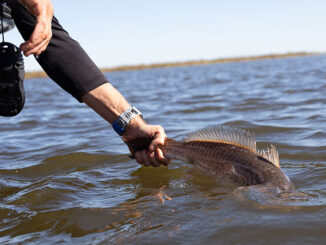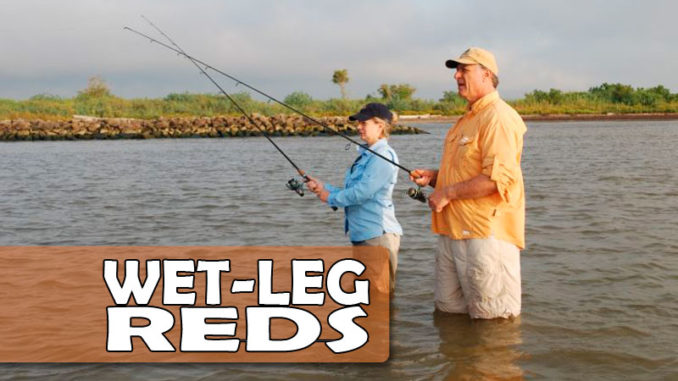
Redfish move into Vermilion Bay, and you can catch all you want at fishing community holes. Or you could bypass the crowds and target these unpressured reds.
The warm Gulf waters swirled soothingly around my legs. The October air was crisp and dry, but the briny broth still carried much of the warmth it stored up during the long Louisiana summer.
Unnoticed by his wife Debbie, the lean, normally reserved 56-year-old Pat Attaway looked at me and grinned broadly — like a little boy in a mud puddle.
He was happy.
This expedition, like so many on which I find myself, started over food.
“I want to cook my mother’s courtbouillon for you,” he said. “I need a redfish for that.”
Redfish are common enough in the fall that getting our fish should have been a pretty pedestrian affair. Then he told me we would be wade fishing in the Gulf of Mexico off of Vermilion Parish’s Cheniere au Tigre.
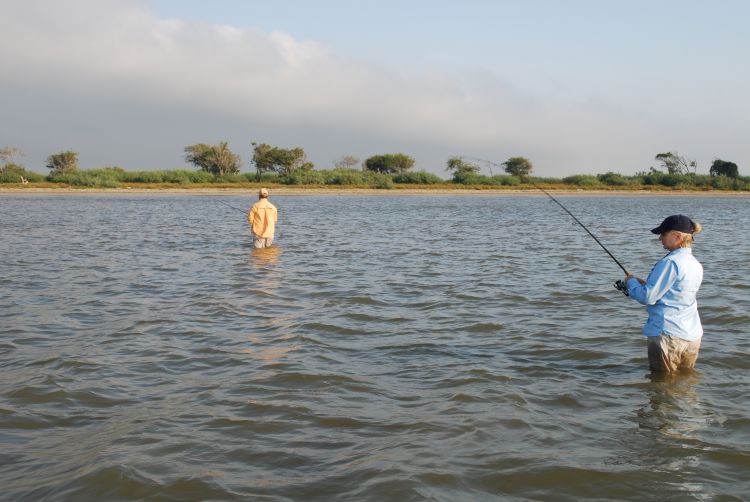
Now that was different.
I was on!
Cheniere au Tigre
Our destination was 4 or 5 miles west of Southwest Pass, where the eastern end of the slight, oak-studded ridge intersects the Gulf of Mexico beach in Vermilion Parish.
I asked Attaway how he found his little-known fishing spot.
“I was riding the coastline one day looking for new spots,” he replied. “I saw the rocks (in the segmented breakwaters) just off the beach, so I hopped out, waded and caught a few trout. I have come back a number of times and caught mostly reds — beautiful redfish.
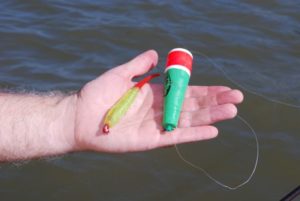
“It’s best in late summer and fall when the Atchafalaya River drops to under 8 feet on the Butte La Rose gauge and during periods of low wind velocity.
“When that happens, the fish move in to the beach,” Attaway said. “It’s challenging to catch it right, though, because strong south winds will muddy the water up.”
In the early morning’s light, Attaway’s sleek V-hull aluminum Hanko swept out of the pass and swung wide into the Gulf to avoid Tete Butte Reef.
Even at this early hour, the big oyster reef was crowded with boats, indicating how popular the local speckled trout fishing landmark is.
He kept the bow of the boat pointed west, passing a monotonous shoreline of marsh and mud. Soon a small clump of live oak trees appeared, followed by an even stronger line of the weather-beaten trees that marched right up to the shoreline.
This was Chenier au Tigre.
Tranquility
Visible in the near distance were multiple elongated rock piles spaced parallel to the shoreline. Called segmented breakwaters, their placement was designed to reduce wave action and the resulting shoreline erosion.
The fact that they work was evident by an accumulation of sand and mud between each breakwater and the bank.
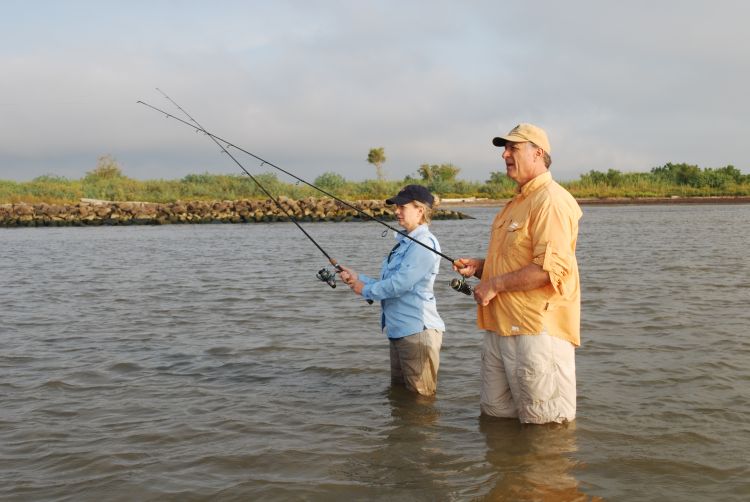 Attaway stopped near the first one, eased his anchor overboard and eyed me with a broad grin on his normally stoic face.
Attaway stopped near the first one, eased his anchor overboard and eyed me with a broad grin on his normally stoic face.
“See what I like here?” he asked while sweeping his arms widely. “No other boats! It’s tranquil.”
He slipped quietly overboard and helped Debbie do the same. The bottom was hard-packed sand; easy wading.
Gear
The couple fan-casted as they slowly walked the area, paying particular attention to the ends of the breakwater.
Their gear was simple; this wasn’t high-tech fishing.
Each used a 7-foot spinning rod and medium-weight reel, a combo Pat Attaway said allowed them to more effectively cast into the wind and, even in calm weather, allowed more casting distance.
The reels were spooled with 10-pound-test braided line. A 4-foot length of 17-pound fluorocarbon was knotted to each line as a leader.
Terminal tackle were 3/8-ounce jigheads tipped with Deadly Dudley Straight Tail soft plastics. Although for variety, they occasionally fished tight-line, most of the time their jigs were hung 2 feet under snap-on popping corks.
“These aren’t the best conditions,” Attaway mumbled as he worked his cork.
The water had a silty appearance, probably from the passage of a mild cold front the night before.
“The tide is falling right now,” Attaway said. “I like a rising tide that pushes clear water up on the beach. The best strategy on high tide is to get behind the rock breakwaters in knee-deep water. The water is shallower there than between the breakwater segments, and the reds will be most often found next to the rocks or in 8 inches of water along the beach behind the breakwaters.
“It’s amazing: You never see the fish tailing or pushing water. You are really fishing blind. You may see something moving toward your cork after you pop it, but you never see them beforehand.”
Specks
Pat Attaway kept peering back to the east, where diving pelicans had caught his attention. Unable to resist the working birds, he quietly summoned Debbie to return to the boat.
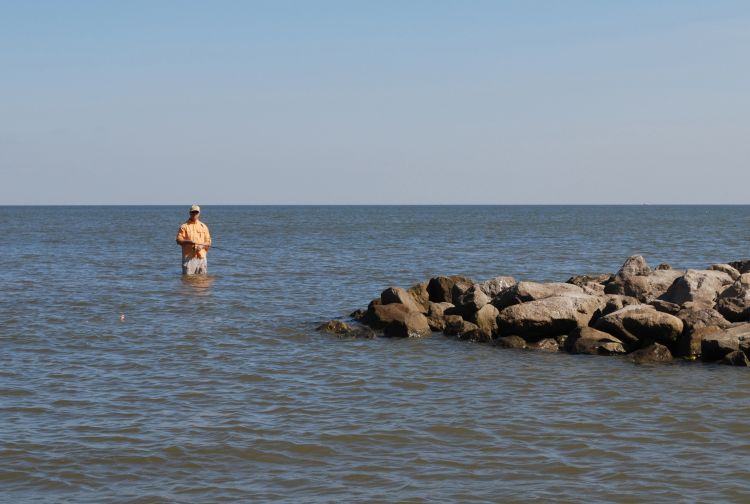
They ran back to within walking distance before anchoring again.
The water was shallower here: only knee deep 200 yards out from the beach. The bottom was laid out in the alternating sandbar-and-trough formation common to all Louisiana beaches.
The couple waded through four troughs before reaching casting distance from the activity, which to Pat’s delight was being produced by feeding speckled trout.
After playing with specks for 45 minutes, the Attaways returned to the rocks.
They needed redfish for Pat’s courtbouillon.
They began where they left off, on the second of about a dozen rocky breakwaters.
Pat’s mind was still on the speckled trout they left.
“I haven’t figured the speckled trout here out yet,” he said. “Sometimes I get them and sometimes I don’t.”
Covered in reds
But the tall, slender angler counts on the breakwaters as a dependable redfish hole.
“When conditions are right, there are hundreds of them — it’s covered in reds,” Pat said. “You catch one every second cast. If you don’t, you go to the next set of rocks and start on them there.
“When you finish there, go back to the first ones and start over.”
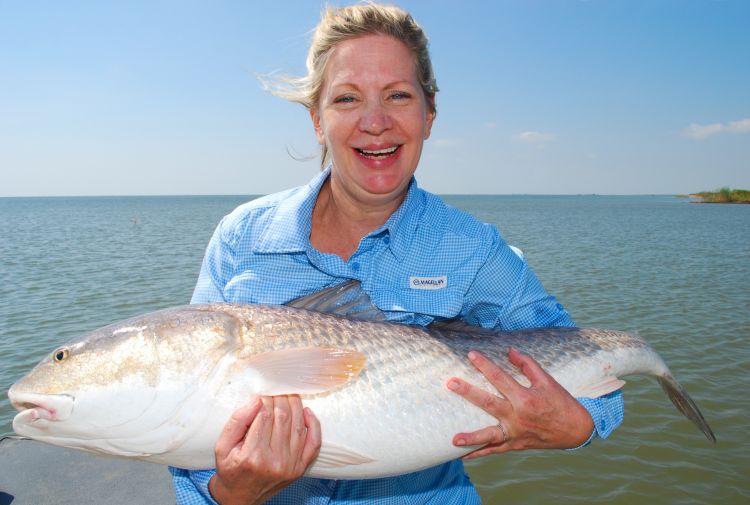
The fish cooperated — slowly.
It was absolutely beautiful. The waves lapped gently on the beach. Shrimp hopped and popped on the water.
“Some days they are all over the place — like hundreds of them,” Pat Attaway said of the shrimp. “I’ve thought about trawling for them, but I catch all I want in Vermilion Bay.”
In spite of all the competition from the natural stuff, Pat sticks to artificial baits, explaining that he has nothing against live bait but considers it a “hassle.”
“You have to cast net for live bait at weirs in the area,” Pat said. “There is no place to buy live bait (in the Vermilion Bay area).”
By mid-morning, the couple had enough. The big redfish Debbie conquered gave her a severe beating.
Pat had redfish for his courtbouillon, and the dedicated speckled trout angler also scratched his itch with a mess of silver beauties.
